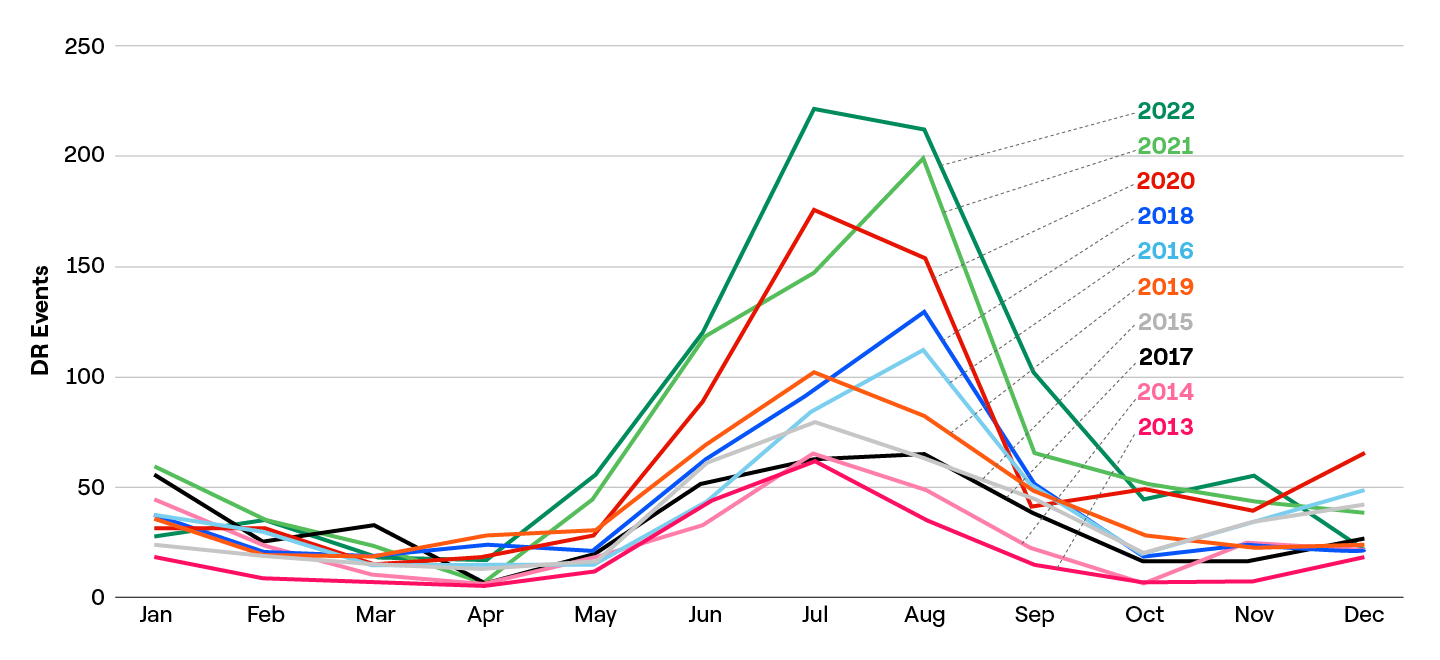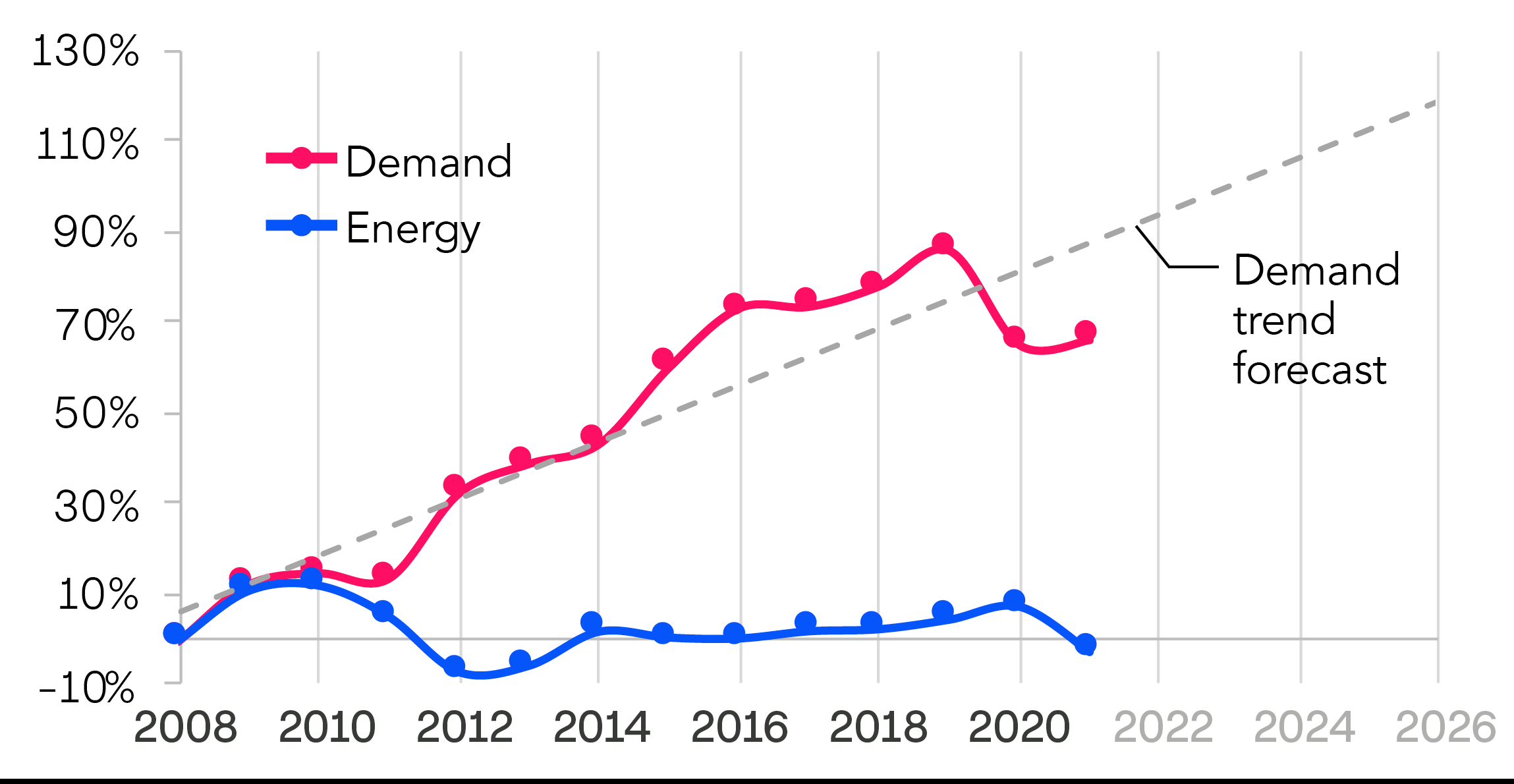Profiting from energy flexibility
Download our eBook to find out how to unlock the revenue potential in your energy infrastructure – and where you may already have that flexibility in your organization.
06 20, 2023
{{ content.description }}
Energy flexibility – the ability to reduce energy use or shift that usage to different times of day as part of grid programs or in response to price signals – is lucrative for individual organizations, essential for electrical grid reliability, and beneficial for the planet. When organizations are flexible with their energy use, grid operators can more easily adjust to the evolving energy landscape.
And as that landscape evolves more quickly, there are signs that energy flexibility could become even more lucrative in the years ahead.
The grid is evolving in a variety of ways, and one important enhancement is the integration of more and more distributed energy resources (DERs). DERs, like solar systems and energy storage, are important to help electrify and decarbonize North America, but because the grid was not initially designed with these modern energy sources in mind, there is a need for strategies that will support the increasing integration of DERs with the grid – while ensuring the grid remains in balance. DERs, in many cases, can even play a starring role in helping ensure grid stability, and we see that role increasing in the future.
One of the many strategies that grid operators are leveraging to adjust to the growth of DERs is embracing energy flexibility programs like demand response. Demand response (DR) is a popular program that allows organizations to earn new revenue for occasionally reducing energy use during times of grid stress. Demand response is a straightforward way for organizations to improve their energy spend and profit from energy flexibility, and it’s a crucial tool that grid operators use to ensure the grid remains in balance for everyday energy consumers.
Demand response has been around for decades, but there are signs that the importance of the program will become even greater in the future. As a pioneer of demand response since the early 2000s, Enel North America experienced a record number of demand response events in 2022.We saw more than 700 demand response events, totaling 5,530 hours, and 38,063 MWh dispatched. Because programs are constantly changing, it’s hard to compare annual totals on an “apples-to-apples” basis – but in comparing a representative sample of programs year over year, the growth is obvious.

The most recent data from 2020, 2021 and 2022 truly stand out in this chart and show that the past few years have seen a drastic increase in demand response events. Some of these events were in response to dramatic headline news in 2022, including 4 days of demand response events during an intense heatwave in California in September and unprecedented emergency events across much of the Northeast, Mid-Atlantic, and Southeast due to record-level freezing weather in December. However, demand response isn’t just needed only for these whole system-wide emergencies anymore. It is most rapidly growing in the ancillary markets, where there is a need for fast-response programs to help alleviate frequency constraints, pricing fluctuations, and localized outages that bring great relief to both the grid and local communities.
With demand response growing, both in terms of the need for grid reliability and demand response program participation, organizations stand to earn significant revenue. In 2022 alone, Enel North America demand response customers received over $150 million in demand response payments. And with growth expected to continue in years ahead, organizations who don’t participate in demand response now may be missing out on lucrative opportunities in the years ahead.
There are other areas where the growing need for energy flexibility is just as clear. Demand charges, for instance, are an important signal grid operators use to encourage flexibility. If you are a large energy user (e.g., steel manufacturer, data center), chances are that a significant portion of your monthly electric bill is made up of demand charges. Unlike energy charges, which are levied based on your kWh consumption, demand charges are levied based on your peak demand during the month – this is typically correlated with the cost of the utility infrastructure required to deliver electricity to your facility during peak hours.
In many states, demand charges are rising much faster than energy charges. We looked at one region in California, for instance, where demand charge growth has drastically outrun energy growth. This growth creates major opportunities for flexibility, both now and in the future.

Economic resilience can be an important part of energy strategy as rates rise in areas across the country. Above, note how California demand charges have grown quickly, drastically outpacing its energy rates, and rising much faster than inflation.
Demand charges are not fixed – because they are based on your peak demand, you can reduce the demand charges on your bill through flexibility by shifting the times you use energy. This can be made even easier with automation – by using solutions like energy storage and energy control software at your facility, you can automatically switch away from grid consumption during hours of peak demand. And as the dotted trend line in the chart shows, if the growth of demand charges continues at this expected pace, that will mean the value of flexibility in avoiding those demand charges will quickly grow – which means more money in your pocket.
The data in both demand response and demand charges shows the growing need for more flexibility, supported by several other industry trends. Among the top energy trends in the decade ahead will be widespread electrification, including that of transport and buildings, like electric vehicles and electric appliances. According to the Brattle Group, “fully electrified heating and transportation (light- and heavy-duty vehicles, rail, etc.) could add up to 3,000 terawatt-hours to U.S. electricity demand by 2050, nearly doubling 2015 electric load.” That’s three billion megawatt-hours. This level of load growth will surely bring with it significant changes to overall energy usage patterns and new energy market dynamics.
Energy flexibility is gaining more support around the world, as well. When the United Nations’ Intergovernmental Panel on Climate Change released their Synthesis Report for their Sixth Assessment Report in 2023, there was notable emphasis on the importance of demand-side measures to prevent catastrophic levels of climate change. Demand-side management is mentioned as crucially important in several parts of the report, which notes with high confidence that alongside energy generation diversification, “demand-side management (e.g., storage and energy efficiency improvements) can increase energy reliability and reduce vulnerabilities to climate change.”
As the grid evolves and grid operators focus on incentivizing demand-side changes, energy flexibility can lead to lucrative earnings and significant bill savings for your organization. These earnings opportunities will likely continue to grow in the years ahead. It basically comes down to this question – are you leaving money on the table?
In addition, many of the best solutions for taking energy flexibility to the next level – like solar and energy storage – are becoming even more attractive due to incentives and tax credits. Transformative legislation, like the Inflation Reduction Act of 2022, is incentivizing the deployment of cleaner, more flexible technologies. If you’ve been on the fence about deploying these types of solutions, now is the time to act so you don’t miss out on this landmark opportunity.
Organizations can reap the benefits of energy flexibility without major disruptions to their day-to-day operations. But it’s crucial to ensure you work with an experienced partner that understands your industry, can tailor a strategy to your organizational operations, and has the expertise to identify and operate the solutions that best align with your priorities.
Enel North America has the experience and expertise with flexibility solutions to help you succeed. As part of Enel, the largest demand response provider in the world, we help organizations capitalize on their energy flexibility to earn new revenue and reduce their energy costs. Contact us today to discover what opportunities you can unlock from your energy infrastructure.